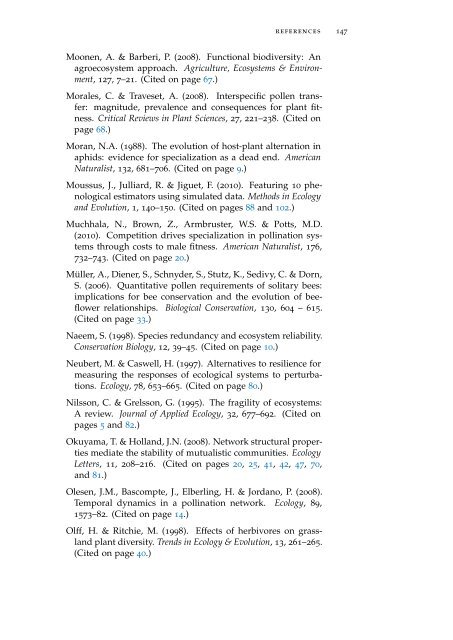Linking Specialisation and Stability of Plant ... - OPUS Würzburg
Linking Specialisation and Stability of Plant ... - OPUS Würzburg
Linking Specialisation and Stability of Plant ... - OPUS Würzburg
Create successful ePaper yourself
Turn your PDF publications into a flip-book with our unique Google optimized e-Paper software.
eferences 147<br />
Moonen, A. & Barberi, P. (2008). Functional biodiversity: An<br />
agroecosystem approach. Agriculture, Ecosystems & Environment,<br />
127, 7–21. (Cited on page 67.)<br />
Morales, C. & Traveset, A. (2008). Interspecific pollen transfer:<br />
magnitude, prevalence <strong>and</strong> consequences for plant fitness.<br />
Critical Reviews in <strong>Plant</strong> Sciences, 27, 221–238. (Cited on<br />
page 68.)<br />
Moran, N.A. (1988). The evolution <strong>of</strong> host-plant alternation in<br />
aphids: evidence for specialization as a dead end. American<br />
Naturalist, 132, 681–706. (Cited on page 9.)<br />
Moussus, J., Julliard, R. & Jiguet, F. (2010). Featuring 10 phenological<br />
estimators using simulated data. Methods in Ecology<br />
<strong>and</strong> Evolution, 1, 140–150. (Cited on pages 88 <strong>and</strong> 102.)<br />
Muchhala, N., Brown, Z., Armbruster, W.S. & Potts, M.D.<br />
(2010). Competition drives specialization in pollination systems<br />
through costs to male fitness. American Naturalist, 176,<br />
732–743. (Cited on page 20.)<br />
Müller, A., Diener, S., Schnyder, S., Stutz, K., Sedivy, C. & Dorn,<br />
S. (2006). Quantitative pollen requirements <strong>of</strong> solitary bees:<br />
implications for bee conservation <strong>and</strong> the evolution <strong>of</strong> beeflower<br />
relationships. Biological Conservation, 130, 604 – 615.<br />
(Cited on page 33.)<br />
Naeem, S. (1998). Species redundancy <strong>and</strong> ecosystem reliability.<br />
Conservation Biology, 12, 39–45. (Cited on page 10.)<br />
Neubert, M. & Caswell, H. (1997). Alternatives to resilience for<br />
measuring the responses <strong>of</strong> ecological systems to perturbations.<br />
Ecology, 78, 653–665. (Cited on page 80.)<br />
Nilsson, C. & Grelsson, G. (1995). The fragility <strong>of</strong> ecosystems:<br />
A review. Journal <strong>of</strong> Applied Ecology, 32, 677–692. (Cited on<br />
pages 5 <strong>and</strong> 82.)<br />
Okuyama, T. & Holl<strong>and</strong>, J.N. (2008). Network structural properties<br />
mediate the stability <strong>of</strong> mutualistic communities. Ecology<br />
Letters, 11, 208–216. (Cited on pages 20, 25, 41, 42, 47, 70,<br />
<strong>and</strong> 81.)<br />
Olesen, J.M., Bascompte, J., Elberling, H. & Jordano, P. (2008).<br />
Temporal dynamics in a pollination network. Ecology, 89,<br />
1573–82. (Cited on page 14.)<br />
Olff, H. & Ritchie, M. (1998). Effects <strong>of</strong> herbivores on grassl<strong>and</strong><br />
plant diversity. Trends in Ecology & Evolution, 13, 261–265.<br />
(Cited on page 40.)
















